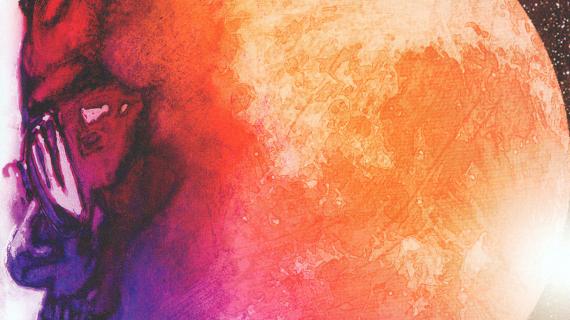As a producer myself, I've always been very attuned to great album artwork. Back when I purchased my first few albums in vinyl or CD form, it was much more challenging to preview music than in our modern streaming age. I sometimes miss the blind faith involved in selecting new music based solely on the artist's name, a vague genre and the album artwork. Incredible sound design should be paired with equally amazing album cover artistry!
Some of my favorite album covers from a variety of bands and artist projects can be found below. All of these are both visually stunning and sonically compelling in my book.
Oneohtrix Point Never
R Plus 7 (2013)
Designer Robert Beatty recreated a still from Georges Schwizgebel's animation "Le ravissement de Frank N. Stein" for this album. For me, It is one of the most beautiful album covers to be released in recent years. The surrealism created by the lighting, the geometric and perfectly balanced figures, and the centrally positioned obscure door that almost looks like a portal—all seamlessly complement the music's surreal, futuristic and alien vision.
Thelonious Monk
Underground (1968)
This is arguably one of the most brilliant album covers ever; it even won a Grammy for Best Album Cover at the time. The photograph, taken at Horn/Griner studio, depicts Thelonious Monk as a wild member of the French resistance holding a Nazi hostage."Monk entered the building, wearing exactly what he wore in the shot (except for the rifle). The cow was standing in the vestibule… she had not yet taken her place on the set. Monk went over and put his arm around her shoulders. He bent down close to her right ear and very calmly and quietly said: 'Moo-o-o-o-o-o-o-o.'"
Franco Battiato
L'era Del Cinghiale Bianco (1979)
Apart from being one of the most important and iconic albums in Italian pop music, the cover art perfectly embodies the world of the Italian songwriter and experimentalist Franco Battiato. It retains the wild explorations of his previous works but adds an incredible pop, oriental and colorful twist. "The era of the white boar" is influenced by René Guenon, a master of occultism and symbolism. Guenon analyzed the figure of the boar, drawing from Celtic traditions and the Hindu belief that animals are sacred/divine figures, naming an era in which every man will reach complete and fulfilling spiritual consciousness.
The Pop Group
Y (1979)
At the helm of The Pop Group's sonic journey is this enigmatic cover art—a photograph captured by legendary Sir Don McCullin. The image transports us to the heart of an African tribal gathering, a visual feast that seamlessly intertwines with the abstruse, schizophrenic and ancestral dance of Y. McCullin's lens skillfully captures the raw, primal energy, mirroring the band's audacious sonic experiments. The cover, with its juxtaposition of light and shadow, serves as a visual prelude to the unconventional rhythms and dissonant melodies that echo throughout the album. This album remains a testament to The Pop Group's fearless no-wave exploration.
Spiritualized
Ladies and Gentlemen We Are Floating In Space (1997)
This exquisite concept album from 1997 is elevated not only by its minimal artwork but also by its meticulous attention to detail, turning every aspect of the LP into a sensory experience. Everything about it resembles a pharmaceutical or lab product, from the sleek, clinical design to the carefully chosen fonts and colors. This aesthetic cohesion perfectly aligns with the magnificent wall of sound and sonic aesthetics of this shoegaze masterpiece, creating a holistic sensory journey for the listener. The album cover, with its pill-like packaging, cleverly suggests that the music itself is a remedy, a capsule of transcendence that, when consumed, propels the listener into an otherworldly realm. The artwork becomes an integral part of the album's narrative, enhancing the overall impact of this groundbreaking musical work.
Antonio Carlos Jobim
Wave (1967)
The album cover for Antonio Carlos Jobim's Wave is a visual ode to the enchanting and rhythmic beauty found within the music. With a serene tropical beach backdrop, the cover invites listeners into the calming world of bossa nova. The gentle waves, the green sky and the lone giraffe figure capture the essence of solitude, creating a perfect visual companion to the soothing melodies within. It's a testament to the seamless fusion of nature's serenity and Jobim's musical artistry, encapsulating the spirit of the album.
Don Caballero
What Burns Never Returns (1998)
This cover depicts a lone house, stoic and silent, under the cosmic limelight of some far-out alien rave. These intergalactic lights almost create a sci-fi stairway to heaven, casting an unearthly glow, set the mood for the musical escapade hidden inside the album. Don Caballero's math rock takes the listener on a sonic adventure through unexplored realms, and the album cover provides a tantalizing preview. The clash between the down-to-earth house and the celestial lights reflects the unpredictable twists of Ian Williams's guitar and the outwardly non-grooves of incredible drummer Damon Che.
Joy Division
Unknown Pleasures (1979)
How could I forget one of the most iconic album artworks of all time? Forty years ago, Joy Division bestowed upon the world their seminal debut studio album, Unknown Pleasures. The iconic front cover, devoid of any words, showcased a black and white data graph featuring 80 distinctive wiggly lines, a graphic representation of the signal from a pulsar known as B1919+21, the first pulsar ever discovered. The stark contrast and minimalism mirror the band's sonic landscape, characterized by haunting vocals and atmospheric instrumentals. The cover's enigmatic nature invites listeners to explore the depths of Joy Division's deep, introspective and emotionally charged music, making it an enduring symbol of the post-punk era.
Bill Evans
Undercurrent (1962)
The cover unfolds like a vintage postcard from another era, featuring the submerged elegance of a woman gracefully floating in some crystalline waters. Fast forward to the release of Undercurrent, and suddenly, this serene aquatic image becomes the symbolic entrance to Bill Evans' unparalleled musical realm. A scene captured in 1947 by photographer Toni Frissell at the magical Weeki Wachee Springs in Florida, known for its enchanting mermaid attraction. As listeners delve into the intricate melodies and harmonies within the album, the submerged mermaid on the cover echoes the submerged beauty of Evans' piano playing. The fusion of Frissell's timeless visual and Evans' timeless music creates an immersive experience that transcends time and genre.
Tim Hecker
Ravedeath, 1972 (2011)
In the captivating sonic world of Tim Hecker's Ravedeath, 1972, the cover art captures a moment in 1972 when MIT students pushed a piano off the roof of Baker House, marking the birth of a university ritual that became an integral part of the album's visual narrative. Hecker, inspired by the chaotic visuals of digital waste and piracy crackdowns, ingeniously selected this cover concept. Licensing the image from the MIT archives, he re-photographed it, embedding the symbolism of the piano-drop ritual into the very fabric of the album. The majority of the sonic tapestry was woven in Fríkirkjan Church, Reykjavík, Iceland, a venue discovered by Hecker himself. On July 21, 2010, he embarked on a concentrated recording session, playing compositions on the pipe organ. The ethereal notes were further enriched by the resonance of guitar and piano. This immersive experience laid the foundation for a record that became an important milestone in ambient music history.
2 Minutes With is our regular interview series where we chat with creatives about their backgrounds, creative inspirations, work they admire and more. For more about 2 Minutes With, or to be considered for the series, please get in touch.






















